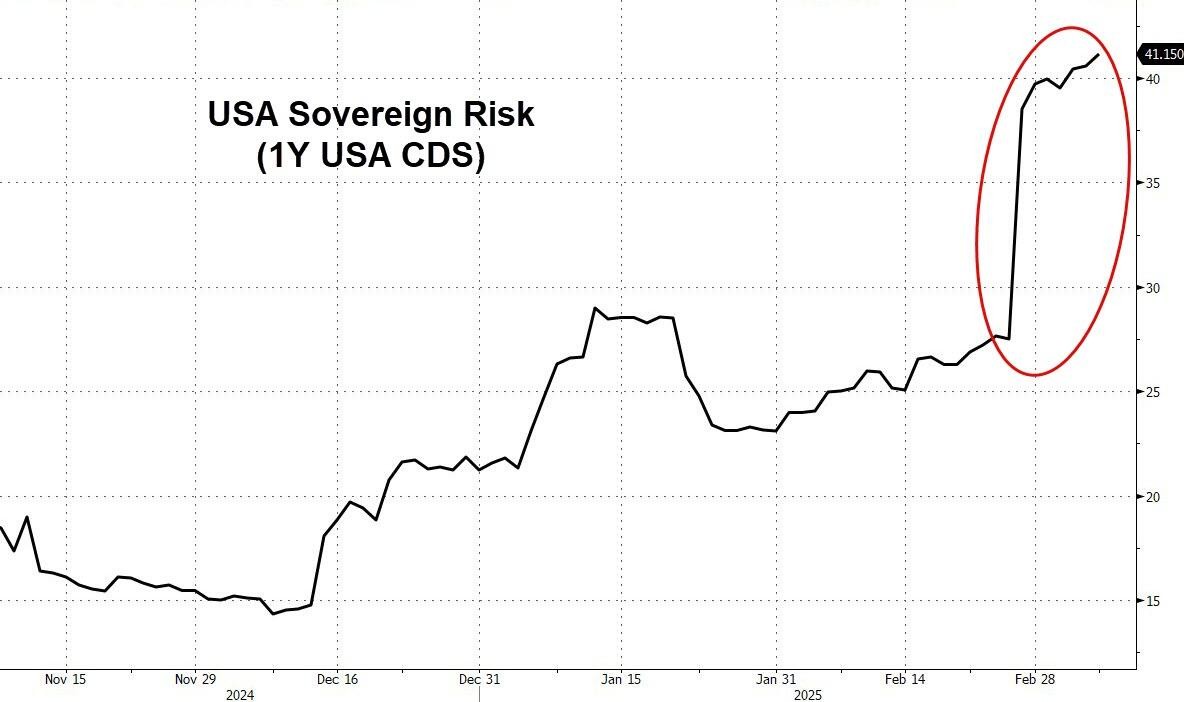
Next week, another "big bomb in the U.S. market" is about to explode

眾議院最早將於本週二對一項稱為 “持續決議” 的臨時支出法案進行投票。分析認為該議案是為了挑釁民主黨,迫他們投下反對票,從而將關門責任推到對方身上。政府停擺一個月可能會導致第一季度 GDP 增長減少 0.4 個百分點,在貿易衝突的擔憂已經攪動股市的背景下,短期內市場波動性或將加劇。
除非國會在 3 月 14 日午夜前通過一項臨時支出法案,否則美國政府將面臨停擺。
眾議院共和黨人此前已提出一項議案,預計最早將於本週二進行投票表決,提案需獲得多數票支持方能通過。然而,民主黨目前大多持反對意見。有分析指出,這或許是為了挑釁民主黨,逼迫他們投下反對票,從而將政府關門的責任推到對方身上。從現狀來看,民主黨和共和黨表面上都希望達成一個方案以避免政府關門,雙方都不願承擔這一責任。
政府停擺對投資者意味着什麼?《巴倫週刊》分析認為,短期內,市場波動性可能會加劇。但根據以往政府停擺期間股市的表現,投資者無需過度恐慌。
當然,這一次的情況可能有所不同:政府停擺發生在貿易衝突的擔憂已經攪動股市的背景下。今年以來,標普 500 指數已下跌超 4%,納斯達克指數下跌超 9%。芝加哥期權交易所波動率指數(VIX)今年上漲 50%,達到 27 左右,表明華爾街的恐慌情緒正在加劇。
黨內分歧與民主黨的立場:提案面臨挑戰
隨着 3 月 14 日政府停擺最後期限臨近,美國總統特朗普於此前呼籲 “所有共和黨人” 投票支持一項 99 頁的支出法案,該法案將維持政府運作至 9 月。
這項法案在很大程度上維持了當前的支出水平,同時為國防項目增加 80 億美元,為退伍軍人醫療保健增加 60 億美元。非國防支出將減少約 130 億美元。
在民主黨不買賬的情況下,眾議院議長 Mike Johnson 正準備在週二對該法案進行投票,實際上是在挑釁,並迫使共和黨人克服在支出問題上的內部分歧,強行通過該法案。
在眾議院,共和黨以 218 對 214 的微弱優勢控制着多數席位,這意味着該提案在眾議院最多隻能失去一票共和黨的支持。
即使眾議院共和黨人設法通過該提案,它也需要在參議院獲得至少 60 票的支持,但目前共和黨僅佔 53 個席位。
民主黨方面表示,如果共和黨不與他們進行協商,他們不會像過去那樣幫助維持政府運轉。他們對這項提案進行了猛烈的抨擊,認為提案賦予特朗普過多權力。民主黨參議員 Patty Murray 也表示,該提案將賦予特朗普和馬斯克通常由國會保留的財政權力。她認為,國會應該通過一項短期措施來防止政府停擺,並完成兩黨合作的撥款法案,以 “確保我們的選民在聯邦資金的使用方式上擁有發言權”。
參議院民主黨領袖 Chuck Schumer 指出,共和黨掌控着政府的所有部門,有責任為政府提供資金,且共和黨尚未就該計劃與他們進行談判:
“我們認為,我們一直認為,唯一的解決方案是兩黨合作的解決方案。”
停擺的影響:GDP 或受損,經濟數據延遲
政府停擺將迫使大部分聯邦僱員停止工作並停發工資。雖然邊境保護、空中交通管制、電網維護以及社保、醫保等核心服務仍將繼續,但國家公園將關閉,環境和食品安全檢查將暫停,美國國立衞生研究院(NIH)的研究人員將無法接收新病人,美國國税局(IRS)的税務協助服務也可能中斷。
據彭博社研究稱,長期停擺帶來的經濟後果將是立竿見影的,但在很大程度上是可以逆轉的。政府停擺一個月可能會導致第一季度 GDP 增長減少 0.4 個百分點,不過一旦恢復正常支出,預計會出現反彈。雖然聯邦工作人員可能會被迫休假,但 3 月份的失業率不會受到影響,但如果僵局持續下去,4 月份的失業率可能會上升 0.5 個百分點。通貨膨脹將出現暫時上升,因為休假的聯邦工作人員的產出不會被計算在內,儘管他們最終會得到報酬。
此外,停擺還將延遲關鍵的經濟報告,如消費者價格指數(CPI)、失業率和零售銷售數據。約 85 萬名聯邦機構工作人員可能被強制休假。
彭博社總結道:
“在正常時期,避免停擺將是一個高度優先事項——但現在,在特朗普執政初期採取的一系列引人注目的舉措中,這只是眾多競爭優先事項之一。目前尚不清楚雙方是否能夠找到共同點。”
此前,當一個政黨控制白宮、眾議院和參議院時,政府只發生過兩次關門——而且兩次都是在特朗普第一屆政府期間。能否避免第三次這樣的事件將取決於雙方如何評估讓政府正常運作陷入停頓的戰術風險。
歷史經驗:停擺短期擾動,長期影響有限
政府停擺對投資者意味着什麼?《巴倫週刊》分析認為,短期內,市場波動性可能會加劇。但根據以往政府停擺期間股市的表現,投資者無需過度恐慌。但美國主權風險表明人們開始感到緊張。

Carson Group 的投資研究團隊的數據顯示,自 1976 年以來,標普 500 指數在過去 22 次政府停擺期間表現平穩。更重要的是,停擺結束後 12 個月內,市場平均上漲 12.7%。
雖然過去的停擺持續時間各不相同,包括吉米·卡特總統任期末的 1 天停擺,以及羅納德·里根總統任期內的 8 次不足 5 天的停擺,但即使是持續時間較長的停擺,也沒有引發投資者的恐慌。
例如,在特朗普總統第一個任期內,從 2018 年 12 月到 2019 年 1 月,政府停擺超過一個月,標普 500 指數反而上漲了 10% 以上。同樣,在奧巴馬總統第二個任期內,2013 年政府停擺 16 天,標普 500 指數上漲超過 3%。
Carson Group 首席市場策略師 Ryan Detrick 表示:
“儘管今年華盛頓的局勢動盪不安,政府停擺的陰影籠罩,但好消息是股市往往會忽略停擺的影響。投資者有很多擔憂,但政府停擺對股市的影響不應是其中之一。”
內憂外患:貿易戰疊加停擺風險,市場恐慌情緒蔓延
當然,這一次的情況可能有所不同:政府停擺發生在貿易衝突的擔憂已經攪動股市的背景下。今年以來,標普 500 指數已下跌超 4%,納斯達克指數下跌超 9%。芝加哥期權交易所波動率指數(VIX)今年上漲 50%,達到 27 左右,表明華爾街的恐慌情緒正在加劇。
Freedom Capital Markets 首席全球策略師 Jay Woods 在一份報告中指出:
“市場往往在截止日期前下跌,然後在臨時停擺與否的情況下反彈。因此,請注意言論開始升温,因為政治姿態開始變得更加響亮。預算糾紛、擬議支出以及當然的光學動態將佔據中心舞台,並可能開始在市場上引起暫時的焦慮。”
投資者擔心關税可能會進一步加劇通脹壓力。最近的一些經濟報告也表明,製造業和勞動力市場正在走弱,引發了對滯脹的擔憂。
儘管如此,投資者可能再次意識到,與其關注華盛頓的噪音,不如更多地關注通常驅動股價的因素:盈利增長。Raymond James 首席投資官 Larry Adam 在一份報告中表示:
“雖然政府停擺可能會帶來短期波動,但我們預計經濟和企業基本面將保持穩固。”

